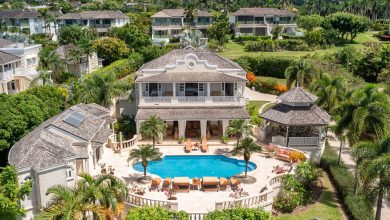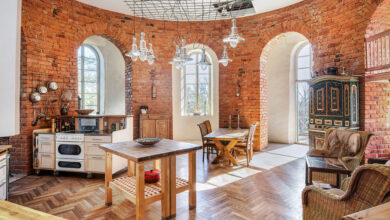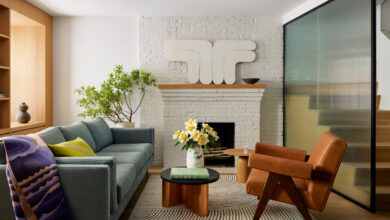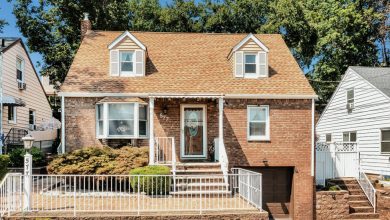Gray Floors Elicit Visceral Reactions. So Why Are They Seemingly Everywhere?

[ad_1]
After the first time Anna Beagley saw gray floors, she couldn’t get them out of her mind. “It was love at first sight,” she said. “They’re a nice, neutral color but still give the room a light, airy vibe.”
She hasn’t looked back since 2021 when she renovated her home in Utah and installed the vinyl gray flooring. “I can add touches of any color I want without really worrying if it will clash,” said Ms. Beagley, 34, an analyst.
But she began to notice an impassioned discourse about dust-colored floors take place online. Tastemakers have drawn a line, and it’s black and white: You either adore them or despise them.
Gray floors have been a source of vitriol for many people, who’ve expressed their distaste on social media with posts that have frequently gone viral. One user tweeted, “Every time original hardwood floors are replaced by gray plank vinyl a year is taken from my life.” Another labeled them “AirBnbcore.” In an Instagram post that has garnered nearly 170,000 likes, designer Bilal Rehman said that gray flooring “sucks the life out of any space that you have.”
At times, all the hatred directed at gray flooring can feel tiresome, Ms. Beagley said. “Sometimes it’s laughable. They’re floors, people. It’s not life or death,” she said. “Other times I get a little frustrated, if you don’t like them don’t get them, but why does anyone feel the need to loudly proclaim their hate for them?”
In the past few years, gray flooring has become a default option among many developers. Designers and architects think the vast grayness is a result of the past decade’s dominating minimalist aesthetic, as well as developers viewing it as a safe and inoffensive option. Gray flooring in apartments is also often laminate — a synthetic material that gives the appearance of wood and is cheaper than real hardwood flooring.
In 2021, “Ultimate Gray” was a Pantone color of the year. Now, as interiors have become inundated with grayness and people closely associate the color with corporate neutrality, some designers are starting to notice clients’ tastes shift away from the ashen, the smoky and the silvery.
Grayed Out
“Gray flooring is the most common type of flooring we use in our multifamily apartment projects,” said Olga Cotofana, the senior director of design at the real estate development company PMG. The company’s buildings with gray floors include a high-rise in Fort Lauderdale, Fla., which opened in 2020, and an apartment complex in Miami’s Wynwood neighborhood, which is set to open later this year. “Gray flooring works well in new construction real estate developments because it appeals to the masses and works well with a variety of interior design and architectural elements on trend currently,” Ms. Cotofana said.
Lowe’s has seen an uptick in sales for gray wood, vinyl and tile, said Dean Schwartz, the company’s senior vice president of merchandising. “Parallel to an increase in consumer demand for a cool, modern aesthetic, we have seen sales of gray floor shades increase in recent years,” said Mr. Schwartz.
“They are nonconfrontational,” said Demetrios A. Comodromos, a co-founder of the architecture firm Method Design. “The desaturated approach also speaks to millennial color sensibilities, like Pepto-Bismol pink, pale yellows and other desaturated colors that have been the fad in recent years.”
For Audra Williams, 47, it’s what the gray floors symbolize that sparks irritation. Ms. Williams lives in a rural part of the Canadian province Nova Scotia, where many homes have been bought by investors and converted into rentals. She saw one particular apartment continue to show up on Facebook Marketplace, and it had gray floors.
“To me, it’s just layers of lack of care or concern for anybody who will be living in that building,” said Ms. Williams, a freelance communications consultant. “People just feel really powerless. So many people who are renting right now cannot find anything other than this super gray, bleak, pretty cheap flooring. People tend to choose it for other people more than they choose it for themselves.”
Diana Viera, a managing partner at the design firm Italkraft, said that she first started to notice gray flooring taking off in the United States after its presence at the Salone del Mobile design fairs in Milan in the 2010s. “Typically, whatever the new design is in Italy, it starts trickling into the U.S.,” she said.
What comes next is a tale perhaps best summed up by Miranda Priestly, the fictional fashion editor played by Meryl Streep, in “The Devil Wears Prada,” explaining to her assistant how trends can flow from high fashion brands to casual wear. After some luxury designers debuted cerulean garments in their collections, she said, “Then it filtered down through the department stores, and then trickled on down into some tragic casual corner where you, no doubt, fished it out of some clearance bin.”
That’s likely the story with gray floors. And because flooring can range from expensive options (like, natural stone or hardwood) to lower-end (such as laminate), the gray color trend could be applied to most types of homes, including McMansions in gated communities, luxury condominiums and older homes being flipped.
“Because you have these huge price differences in materials, it allows you to market so that everybody’s doing it,” said Ms. Viera.
But now that gray flooring is omnipresent and isn’t something intentional or seemingly new anymore, people don’t want it so badly, Ms. Viera said.
Among wealthy homeowners, a shift away from gray is already in motion. “In high-end, luxury residential homes that are very custom, those are the first people to start going in a different direction because they can afford something different,” said Ms. Viera. Those clients of hers are moving toward the extremes, either black floors or very light, sand tones, she added.
However, many people don’t have the luxury and extra income necessary to decide against a housing unit simply because it has gray floors.
Lucía Massucco, a 28-year-old artist, is no fan of the flooring. “It’s impossible to have a warm, cozy ambience with them,” said Ms. Massucco. “They have a very soul-deprived and clinical feeling.”
But last year when she was apartment hunting in Vancouver, British Columbia, Ms. Massucco found it difficult to find an up-to-date apartment that didn’t have gray floors. Any option with other types of flooring, she found, were either luxury units way out of her budget or old and rundown. Deciding against going broke for a matter of aesthetics or risking living with bedbugs, she went for a one-bedroom apartment lined with light-gray planks.
Feeling stuck with the gray flooring has led to all the backlash online.
‘Soulless,’ but ‘Functional’
Social media gives a platform for people’s tastes to be spread and distaste to turn viral — being a hater can lead to likes and followers.
Floors are subject to the same fast-spinning trend cycle that has already come for jeans, house plants, headphones or croissants. The internet doesn’t help slow things down either, making the hottest trend look all the more elusive, appearing and disappearing so fast that most people can’t keep up.
And in a few years — or sometimes even sooner — people begin to hate them. For example, parquet floors — in which wood slats are arranged in repeating, geometric patterns — were once all the rage in the 1960s and ’70s in New York. Today, clients are turned off by them, said Keyan Sanai, an agent at Douglas Elliman in New York. “That’s something I have to hide now,” he said.
And while he’s heard the complaints about gray flooring lately, Mr. Sanai said that sometimes it’s preferable among clients because it means that the apartment has been recently updated, even if it isn’t the most thoughtfully designed. “If you’re lucky enough to have floors that aren’t from 100 years ago in a New York City apartment, I think that’s exciting as is,” he said.
Claire Lower, a 36-year-old editor at Lifehacker, a blog for life hacks, bought her Portland, Ore., home, which came with gray floors, in 2020. She called the floors “soulless” and “corporate neutral,” but noted that they were, at least, easy to clean. “They’re functional. There’s nothing wrong with them, so they’re not a priority to be redone,” she said.
Still, Ms. Beagley is in love with her gray floors. “When I found gray floors, I was just absolutely over the moon,” she said. “I can add touches of any color I want without really worrying if it will clash.”
[ad_2]
Source link






